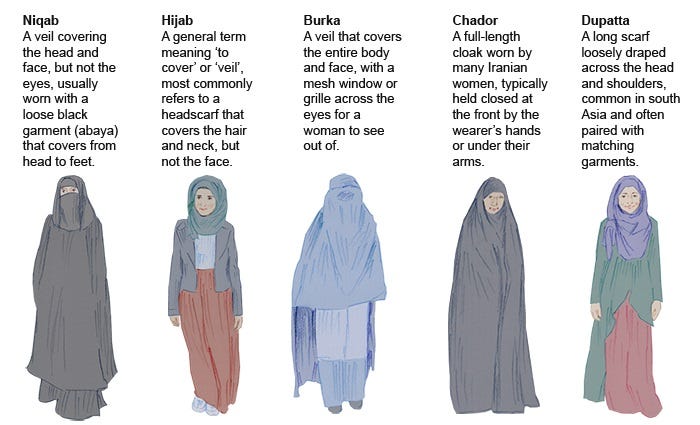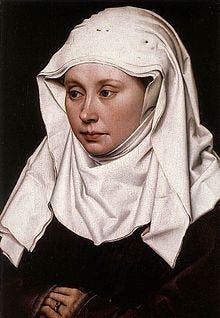In my book, I’m writing a scene that involves an Islamic woman singing for Richard the Lionheart. This might sound like a romantic invention, but such a performance is recorded in history. The contemporary Muslim chronicler Ibn Al-Athir, writing during Richard’s lifetime, reported that during one of Richard’s negotiating meetings with Saladin’s brother Al-Adil, a female singer was summoned to perform traditional music for the king.
Those of you who have been reading along know that Richard, in addition to being a fearsome warrior, was also a lover of music, even writing his own songs. It ran in the family—Richard’s great-grandfather William IX, Eleanor of Aquitaine’s grandfather, is known as the first troubadour. But we’re not here to talk about troubadours today (but I promise, that’s coming). We’re hear to talk about veils.
When I first wrote this scene, without even thinking about it, I wrote that the performer was veiled. And she would be, wouldn’t she be? Much of what I know of Arab culture in the medieval era is shaped by Ridley Scott movies. As I have worked on this book, I have learned that questioning small details like this often leads me to interesting things, and to realize that my superficial, instinctive ideas are often just wrong.
Witness my learning about bowing in medieval Arabic culture. It wasn’t really a thing, actually:
But back to veils.
Veils are usually associated with Islamic women, together with related types of dress such as the Hijab, Niqab, Burqa, and others. At least, I have that association. But what is true today might not have been true in the medieval era. And veils, headscarves and other forms of headcovering have a history that long pre-dates Islam, written into law in Assyria as far back as the 13th century BC.1 Muslim forms of dress have created current controversies, as various governments attempt to prevent Muslim women from wearing these traditional items, but that’s not the subject of this post.

Time to question the unquestioned assumptions.
If you google medieval Arabic veils, one of the first things you learn is that the people who wore veils in the medieval era were mostly…Christian.
Yep. Christians, not Muslims, mostly wore the veil in the Middle Ages. If you remember your bible verses, this might not come as a complete shock. For example, there is the famous passage of the first letter to the Corinthians (11:2-16):
….. But I want you to realize that the head of every man is Christ, and the head of the woman is man…every woman who prays or prophesies with her head uncovered dishonors her head—it is the same as having her head shaved. For if a woman does not cover her head, she might as well have her hair cut off; but if it is a disgrace for a woman to have her hair cut off or her head shaved, then she should cover her head. A man ought not to cover his head since he is the image and glory of God; but woman is the glory of man.2
Call it the veil, the wimple or gorget, head-covering by “respectable” Christian women was ubiquitous in the middle ages, and is easily seen in the iconography of the era.

In 1279, Cardinal Latino Malabranca formulated a series of rules, one of which reiterated the obligation for married (Christian) women who were over 18-years-old to wear the veil.3 By the late Middle Ages, almost all women wore veils when leaving the house but often also within the house.4 Veils were very much associated with virtue and respectability. In fact, if an “honest” woman from the French town of Arles saw a prostitute wearing a veil, she had the legal right to rip it off.5 Lastly, we recall that the phrase “taking the veil” is a common euphemism for becoming a nun.
There are references to Islamic women wearing the veil during the medieval and pre-medieval era, but these references is Islam are primarily and specifically related to the wives of Muhammad himself. Opinions seem to vary on whether the requirement to wear a veil was specific to Muhammad’s wives, or were a broader phenomena, during that era. Arabic veils were sometimes worn as a status symbols—a respectable woman might wear a veil to distinguish herself from slaves and unchaste women.5
In the process of researching female Arabic musicians in the medieval era, I also learned that there was an entire slave caste of female musicians called Qiyān6. Not unlike the troubadours, they were performers and entertainers with a clearly defined place in the culture. Perhaps more precisely equivalent to the geisha in Japan, Qiyān provided musical performances as well as cultural entertainment, poetry and calligraphy, as well as providing more intimate forms of companionship. They could be found all the way from the Egyptian Caliphate courts all the way to the Al-Andulus region of Muslim Spain. Until roughly the time of Richard, the Qiyān were almost always female. But during that era, more and more performers became male.7
The blog of the musical group Qiyan Krets (who perform music inspired by that of the Qiyān) even suggest that William of Aquitaine grew up with Qiyans and was influenced by them.
But, returning to the question at hand! Combining the all of this, our female singer performing for Richard was likely a slave, and also unlikely to have worn a veil.
https://www.cnn.com/style/article/headscarf-brief-history/index.html
https://mvstconference.ace.fordham.edu/MVSTconf2018/the-paradoxical-story-of-the-veil-in-the-middle-ages/
https://mvstconference.ace.fordham.edu/MVSTconf2018/the-paradoxical-story-of-the-veil-in-the-middle-ages/
https://www.materializedidentities.com/single-post/2017/03/05/is-a-veil-a-veil-maria-giuseppina-muzzarelli-s-a-capo-coperto
https://www.eiu.edu/historia/Slininger2014.pdf
https://networks.h-net.org/node/11465/discussions/80565/singing-slave-women-medieval-islamic-court-research-and-teaching
https://daily.jstor.org/music-and-gender-in-medieval-islamic-court/





